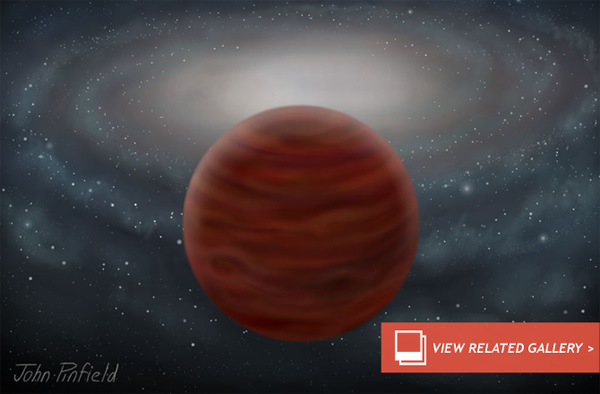Ancient and Stealthy: Methuselah Brown Dwarfs Found
Using data from NASA’s Wide-field Infrared Survey Explorer (WISE), astronomers have detected two ancient “failed stars” that are likely 10 billion years old. The discovery of the ancient pair has led to an estimate that there are likely billions of these previously unseen brown dwarfs barreling through our galaxy at high speed.
The University of Hertfordshire astronomers, led by David Pinfield, clocked the two brown dwarfs traveling at a breakneck velocity of 100-200 kilometers per second, far faster than younger stars and brown dwarfs. WISE 0013+0634 and WISE 0833+0052 were spotted through the detection of their very faint infrared signals in the constellations Pisces and Hydra, respectively.
Brown dwarfs form the stellar bridge between massive planets and small stars. They possess characteristics of both stars and planets, but cannot be defined as either. Brown dwarfs are too small to sustain nuclear fusion in their cores, hence the “failed star” moniker, but they lack material stratification through their bodies, so they don’t fall into the planetary category either — they could just as easily be nicknamed “overachieving planets.” As brown dwarfs are cool objects — these two new discoveries are thought to have temperatures between 250-600 degrees Celsius (520-870 Kelvin or 480-1,100 Fahrenheit) — only the most sensitive of infrared observatories can detect their weak infrared emissions.
With the help of follow-up studies by ground-based observatories, the researchers identified an abundance of hydrogen in the brown dwarfs’ atmospheres. Through spectroscopic analysis, they also revealed a dearth of heavy elements commonly found in younger stellar objects. Heavy elements (i.e. any element heavier than hydrogen and helium) are created in the cores of massive stars and supernovae — the low metallicity of these two objects therefore betray their ancient origins; they were formed from primordial interstellar gases when our galaxy was a fraction of the age it is now.
Nearby stars belong to one of three stellar populations: the thin disk, thick disk or halo. The latter two are known to contain some of the most ancient of stars. Also, stars in the thick disk and halo also have the highest velocities, a characteristic the two brown dwarfs possess. But owed to their very weak infrared emission, Methuselah brown dwarfs like WISE 0013+0634 and WISE 0833+0052 are very hard to detect, requiring some very clever astronomical techniques and data analysis.
According to the researchers, 97 percent of local stars belong to the thin disk population, including our comparatively young sun, while just 3 percent belong in the thick disk and halo populations. Considering 70 billion brown dwarfs are thought to live in the thin disk, if the number of stars is representative of the population of brown dwarfs, 3 percent represents at least 2 billion hard-to-detect brown dwarfs that formed in the Milky Way’s formative years, but are now zooming around the thick disk and halo regions.
“These two brown dwarfs may be the tip of an iceberg and are an intriguing piece of astronomical archaeology,” said Pinfield in a press release. “We have only been able to find these objects by searching for the faintest and coolest things possible with WISE. And by finding more of them we will gain insight into the earliest epoch of the history of the galaxy.”
This research has been published in the journal Monthly Notices of the Royal Astronomical Society and is available via the arXiv preprint service (arXiv:1308.0495 [astro-ph.GA]).
Image: A brown dwarf from the thick-disk or halo is shown. Although astronomers observe these objects as they pass near to the solar system, they spend much of their time away from the busiest part of the galaxy, and the Milky Way’s disk can be seen in the background. Credit: John Pinfield(Nov 21, 2013 02:27 PM ET // by Ian O'Neill)












